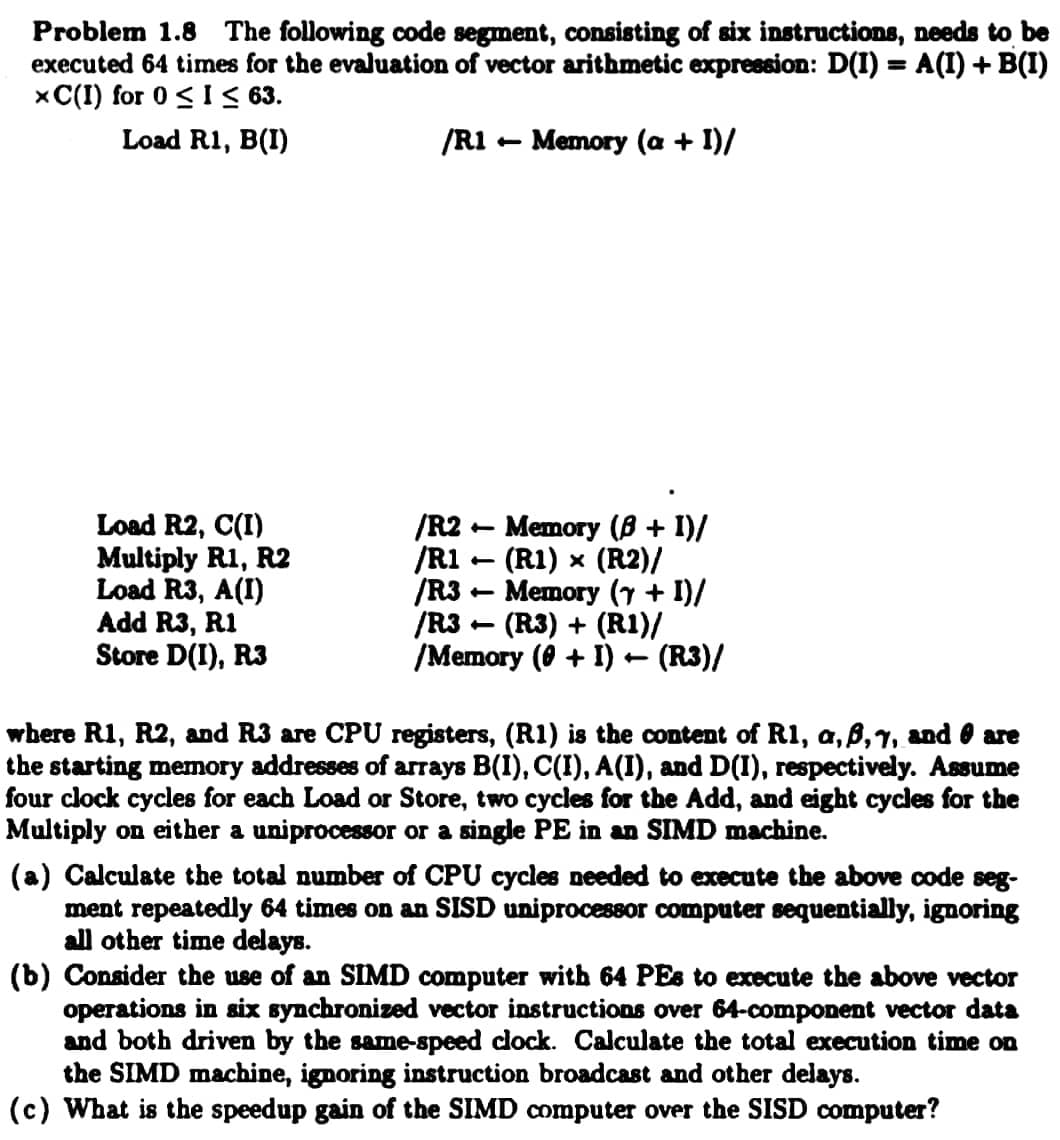Problem 1.8 The following code segment, consisting of six instructions, needs to be executed 64 times for the evaluation of vector arithmetic expression: D(I) = A(I) + B(I) xC(I) for 0 ≤ I≤ 63. Load R1, B(I) Memory (a + I)/ Load R2, C(I) Multiply R1, R2 Load R3, A(I) Add R3, R1 Store D(I), R3 /R1 Memory (B + 1)/ (R1) × (R2)/ Memory (7 + I)/ (R3) + (R1)/ /Memory (0+ I) ← (R3)/ /R2 /R1 /R3 /R3 t where R1, R2, and R3 are CPU registers, (R1) is the content of R1, a,6,7, and are he starting memory addresses of arrays B(1), C(I), A(I), and D(I), respectively. Assume our clock cycles for each Load or Store, two cycles for the Add, and eight cycles for the Multiply on either a uniprocessor or a single PE in an SIMD machine. (a) Calculate the total number of CPU cycles needed to execute the above code seg- ment repeatedly 64 times on an SISD uniprocessor computer sequentially, ignoring all other time delays. (b) Consider the use of an SIMD computer with 64 PEs to execute the above vector operations in six synchronized vector instructions over 64-component vector data and both driven by the same-speed clock. Calculate the total execution time on the SIMD machine, ignoring instruction broadcast and other delays. (c) What is the speedup gain of the SIMD computer over the SISD computer?
Problem 1.8 The following code segment, consisting of six instructions, needs to be executed 64 times for the evaluation of vector arithmetic expression: D(I) = A(I) + B(I) xC(I) for 0 ≤ I≤ 63. Load R1, B(I) Memory (a + I)/ Load R2, C(I) Multiply R1, R2 Load R3, A(I) Add R3, R1 Store D(I), R3 /R1 Memory (B + 1)/ (R1) × (R2)/ Memory (7 + I)/ (R3) + (R1)/ /Memory (0+ I) ← (R3)/ /R2 /R1 /R3 /R3 t where R1, R2, and R3 are CPU registers, (R1) is the content of R1, a,6,7, and are he starting memory addresses of arrays B(1), C(I), A(I), and D(I), respectively. Assume our clock cycles for each Load or Store, two cycles for the Add, and eight cycles for the Multiply on either a uniprocessor or a single PE in an SIMD machine. (a) Calculate the total number of CPU cycles needed to execute the above code seg- ment repeatedly 64 times on an SISD uniprocessor computer sequentially, ignoring all other time delays. (b) Consider the use of an SIMD computer with 64 PEs to execute the above vector operations in six synchronized vector instructions over 64-component vector data and both driven by the same-speed clock. Calculate the total execution time on the SIMD machine, ignoring instruction broadcast and other delays. (c) What is the speedup gain of the SIMD computer over the SISD computer?
Introductory Circuit Analysis (13th Edition)
13th Edition
ISBN:9780133923605
Author:Robert L. Boylestad
Publisher:Robert L. Boylestad
Chapter1: Introduction
Section: Chapter Questions
Problem 1P: Visit your local library (at school or home) and describe the extent to which it provides literature...
Related questions
Question

Transcribed Image Text:Problem 1.8 The following code segment, consisting of six instructions, needs to be
executed 64 times for the evaluation of vector arithmetic expression: D(I) = A(I) + B(I)
xC(I) for 0 ≤ I ≤ 63.
Load R1, B(I)
/R1 - Memory (a + I)/
Load R2, C(I)
Multiply R1, R2
Load R3, A(I)
Add R3, R1
Store D(I), R3
t
/R2 Memory (8 + 1)/
/R1 - (R1) × (R2)/
/R3
-
Memory (7 + I)/
-
/R3 (R3) + (R1)/
/Memory (0 + I) ← (R3)/
where R1, R2, and R3 are CPU registers, (R1) is the content of R1, a, ß,7, and are
the starting memory addresses of arrays B(1), C(I), A(I), and D(I), respectively. Assume
four clock cycles for each Load or Store, two cycles for the Add, and eight cycles for the
Multiply on either a uniprocessor or a single PE in an SIMD machine.
(a) Calculate the total
ber of CPU cycles needed to execute the above code seg-
ment repeatedly 64 times on an SISD uniprocessor computer sequentially, ignoring
all other time delays.
(b) Consider the use of an SIMD computer with 64 PEs to execute the above vector
operations in six synchronized vector instructions over 64-component vector data
and both driven by the same-speed clock. Calculate the total execution time on
the SIMD machine, ignoring instruction broadcast and other delays.
(c) What is the speedup gain of the SIMD computer over the SISD computer?
Expert Solution
This question has been solved!
Explore an expertly crafted, step-by-step solution for a thorough understanding of key concepts.
Step by step
Solved in 5 steps

Knowledge Booster
Learn more about
Need a deep-dive on the concept behind this application? Look no further. Learn more about this topic, electrical-engineering and related others by exploring similar questions and additional content below.Recommended textbooks for you

Introductory Circuit Analysis (13th Edition)
Electrical Engineering
ISBN:
9780133923605
Author:
Robert L. Boylestad
Publisher:
PEARSON

Delmar's Standard Textbook Of Electricity
Electrical Engineering
ISBN:
9781337900348
Author:
Stephen L. Herman
Publisher:
Cengage Learning

Programmable Logic Controllers
Electrical Engineering
ISBN:
9780073373843
Author:
Frank D. Petruzella
Publisher:
McGraw-Hill Education

Introductory Circuit Analysis (13th Edition)
Electrical Engineering
ISBN:
9780133923605
Author:
Robert L. Boylestad
Publisher:
PEARSON

Delmar's Standard Textbook Of Electricity
Electrical Engineering
ISBN:
9781337900348
Author:
Stephen L. Herman
Publisher:
Cengage Learning

Programmable Logic Controllers
Electrical Engineering
ISBN:
9780073373843
Author:
Frank D. Petruzella
Publisher:
McGraw-Hill Education

Fundamentals of Electric Circuits
Electrical Engineering
ISBN:
9780078028229
Author:
Charles K Alexander, Matthew Sadiku
Publisher:
McGraw-Hill Education

Electric Circuits. (11th Edition)
Electrical Engineering
ISBN:
9780134746968
Author:
James W. Nilsson, Susan Riedel
Publisher:
PEARSON

Engineering Electromagnetics
Electrical Engineering
ISBN:
9780078028151
Author:
Hayt, William H. (william Hart), Jr, BUCK, John A.
Publisher:
Mcgraw-hill Education,